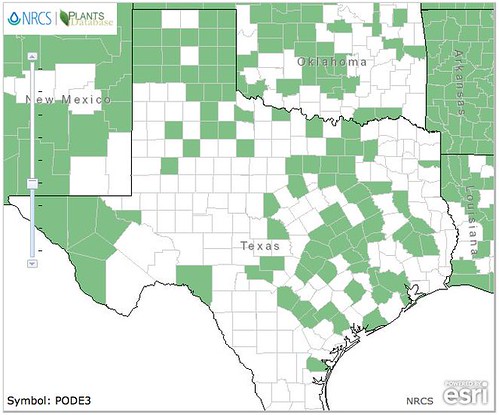Abundance: rare
What: inner bark
How: raw, cooked
Where: sunny fields near water
When: spring, summer, fall, winter
Nutritional Value: calories, vitamin C
Dangers: none
Medicinal Summary:
Young Bark - anti-inflammatory; pain reliever; fever reducer (tisane)
Leaf Buds - pain reliever; antimicrobial, heals sprains and contusions (infused oil)

Cottonwood branch.

Cottonwood leaves in early fall with both green and yellow leaves.

Cottonwood bark.

Texas distribution, attributed to U. S. Department of Agriculture. The marked counties are guidelines only. Plants may appear in other counties, especially if used in landscaping.

North American distribution, attributed to U. S. Department of Agriculture.

Cottonwood trees were a welcome sight for those settlers and Native Americans crossing Texas. Their presence indicated water within easy digging distance. Quick growing, they can reach 100 feet tall with a spread of 75 feet in under twenty years. In the early summer Cottonwoods produce LOTS of the cottony fluff for which they are named. Come fall their leaves take on a striking yellow color which stands out boldly among the lesser trees and bushes.
The inner bark (cambium layer) is a good source of calories and vitamin C. One must peel away the thick, outer bark to get to this edible cambium layer. The cambium is finely diced before eating to lessen the amount of chewing needed. It can be eaten raw or boiled into a porridge. Please note that removing this inner bark will likely kill the tree and Cottonwoods are becoming rare in Texas. Please harvest the bark only in a matter of life or death. However, Cottonwoods shed branches during storms. Harvest the cambium layer from these fallen branches as soon as possible.
During the winter Cottonwoods protect their next year's leaf buds with a resinous coating. These buds were collected in the winter and gently boiled in an edible oil to make a salve to treat sore throats and coughs. Being a relative of willows, the bark of the Cottonwood can also be used as a source of aspirin.
Buy my book! Outdoor Adventure Guides Foraging covers 70 of North America's tastiest and easy to find wild edibles shown with the same big pictures as here on the Foraging Texas website.

